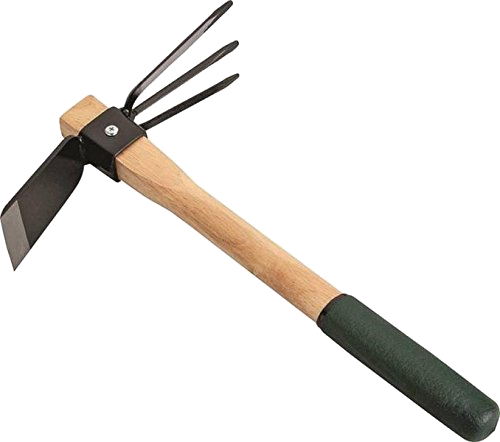

|

|
Hand Hoe & Cultivator |

I recommend sharpening the edge furthest away from the user as it makes the angle for using the tool easier, i.e., the user can swing the tool easier. |

|
| General Guidelines | |||
|---|---|---|---|
| Purpose | α | β | Notes |
| General Use | 20° |
10 - 20° |
This is a good selection for weeding in the garden and breaking up dirt clods. It is sharp enough that it shears the weeds well at the ground level. |
Shaping the edge: New hand hoes I have purchased have an angle (α) of 20°, and no secondary bevel (β). Therefore, initial shaping of the edge is to be expected.
The secondary bevel angle (β) is a good idea as such a sharp angle on the tool makes an edge which is easily damaged. Increasing the angle by adding a secondard bevel helps.
Do not use power tools to shape this tool. The cutting edges are typically made of carbon steel, and use of power tools would easily remove any temper the steel has.
Sharpening the edge: Use a Tormek or a machinist’s hand file. If using a file:
A 6" smooth cut machinist’s hand file is useful to carry in your gardening tools box. Use it to resharpen the hoe as needed through the gardening activity.
Honing the edge: Honing is not needed.
After Use: Be sure to remove all caked-on dirt. If left in place, this will encourage rust, especially on the unpainted surfaces. A wire brush or putty knife can be useful for this.
A well-kept tool will last your lifetime, and will still be usable by your children (and maybe your grandkids).
Sap can be removed using a solvent. Acetone works well, but be sure to wear protective clothing as this is not kind to your body, and be sure the area is well ventilated. After using any solvent, be sure to apply a thin coat of camellia oil to the axe.
If the tool was exposed to any diseased plants or soil which is infected with pests, give it a quick wash in diluted bleach (1 part bleach to 8 parts water), and then rinse with plain water. Be sure to dry afterwards, and apply a thin coat of camellia oil.
Storing the Tool: These tools often get stored for a while after sharpening, so it is recomended to oil the sharpened surface with camellia oil. (Indeed, all unpainted surfaces would benefit from this.). I like the spray bottle of camellia oil sold by Tools for Working Wood. Some advocate using boiled linseed oil (BLO), but BLO often has heavy metals or other bad chemicals added for drying agents, and these are not good for you to handle, nor would they be good for the plants on which you'll use this tool.